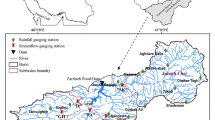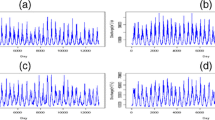Abstract
Multivariate time series modeling approaches are known as valuable methods for simulating and forecasting the temporal evolution of hydroclimatic variables. These approaches are also useful for modeling the temporal dependence and cross-dependence between variables and sites. Although multiple linear time series approaches, such as vector autoregressive (VAR) and multiple generalized autoregressive conditional heteroscedasticity (MGARCH) approaches are ordinarily applied in finance and econometrics, these methods have not been broadly applied in hydrology science. The present research employs the VAR and VAR–MGARCH methods to model the mean and conditional variance (heteroscedasticity) of daily streamflow data in the Zarrineh Rood dam watershed, in northwestern Iran. The bivariate diagonal vectorization heteroscedasticity (DVECH) model, as one of the key MGARCH models, demonstrates how the conditional variance, covariance, and correlation structures change in time between the residual time series from VAR model. In this regards, in the present study, five experiments which present different combinations of twofold streamflows (including both upstream and downstream stations) are conducted. The VAR approach is fitted to the twofold daily time series in each of the experiments with different orders. The Portmanteau test, as a formal test for demonstrating time-varying variance (or so-called ARCH effect), indicates the existence of conditional heteroscedastic behavior in the twofold residual time series obtained from the VAR models fitted to the twofold streamflows. Thus, the VAR–DVECH approach is suggested to capture the inherent heteroscedasticity in daily streamflow series. The bivariate DVECH approach indicates short-term and long-term persistency in the conditional variance–covariance structure of the twofold residuals of streamflows. Results show also that the use of the nonlinear bivariate DVECH model improves streamflow modeling efficiency by capturing the heteroscedasticity in the twofold residuals obtained from the VAR model for all experiments. The assessment criteria indicate also that the VAR–DVECH approach leads to a better performance than the VAR model.












Similar content being viewed by others
References
Bollerslev T (1986) Generalized autoregressive conditional heteroscedasticity. J Econom 31(3):307–327
Bollerslev T, Engle RF, Wooldridge JM (1988) A capital asset pricing model with time varying covariances. J Polit Econ 96(1):116–131
Box GEP, Jenkins GM, Reinsel G (2008) Time series analysis: forecasting and control, 4th edn. Wiley, Hoboken
Chang C, Khamkaew T, McAleer M (2011) Modelling conditional correlations in the volatility of Asian rubber spot and futures returns. Math Comput Simul 81(7):1482–1490
Dawson CW, Wilby RL (2001) Hydrological modeling using artificial neural networks. Prog Phys Geogr 25(1):80–108
Dawson CW, Abrahart RJ, See LM (2007) Hydrotest: a web-based toolbox of evaluation metrics for the standardized assessment of hydrological forecasts. Environ Model Softw 22(7):1034–1052
Engle RF (1982) Autoregressive conditional heteroscedasticity with estimates of variance of United Kingdom inflation. J Econom Soc 50(4):987–1007
Engle RF, Kroner KF (1995) Multivariate simultaneous multivariate ARCH. Econom Theory 11(1):122–150
Fathian F, Morid S, Kahya E (2015) Identification of trends in hydrological and climatic variables in Urmia Lake basin. Iran Theor Appl Climatol 119:443–464
Fathian F, Modarres R, Dehghan Z (2016) Urmia Lake water-level change detection and modeling. Model Earth Syst Environ 2(4):203. https://doi.org/10.1007/s40808-016-0253-0
Fathian F, Fakheri-Fard A, Modarres R, van Gelder PHAJM (2018) Regional scale rainfall–runoff modeling using VARX–MGARCH approach. Stoch Environ Res Risk Assess 32(4):999–1016
Francq C, Zakoian JM (2011) GARCH models: structure, statistical inference and financial applications. Wiley, Chichester
Hipel KW, McLeod AE (1996) Time series modeling of water resources and environmental systems. Elsevier, Amsterdam
Järas J, Gishani AM (2010) Threshold detection in autoregressive non-linear models. M. A. Thesis, Department of Statistics, Lund University
Karimi S, Shiri J, Kisi O, Shiri AA (2015) Short-term and long-term streamflow prediction by using wavelet–gene expression programming approach. ISH J Hydraul Eng 22(2):148–162. https://doi.org/10.1080/09715010.2015.1103201
Kisi O, Shiri J (2011) Precipitation forecasting using wavelet-genetic programming and wavelet-neuro-fuzzy conjunction models. Water Resour Manage 25(13):3135–3152
Li WK (2004) Diagnostic checks in time series. Chapman & Hall/CRC, Boca Raton
Liang Z, Li Y, Hu Y, Li B, Wang J (2018) A data-driven SVR model for long-term runoff prediction and uncertainty analysis based on the Bayesian framework. Theoret Appl Climatol 133(1–2):137–149
Liu GQ (2011) Comparison of regression and ARIMA models with neural network models to forecast the daily streamflow of White Clay Creek. PhD dissertation, University of Delaware
Livina V, Ashkenazy Y, Kizner Z, Strygin V, Bunde A, Havlin S (2003) A stochastic model of river discharge fluctuations. Phys A 330(1):283–290
Matalas NC (1967) Mathematical assessment of synthetic hydrology. Water Resour Res 3(4):937–945
Matalas NC, Wallis JR (1971) Statistical properties of multivariate fractional noise processes. Water Resour Res 7(6):1460–1468
Modarres R, Ouarda TBMJ (2012) Generalized autoregressive conditional heteroscedasticity modelling of hydrologic time series. Hydrol Process 27(22):3174–3191
Modarres R, Ouarda TBMJ (2013a) Modeling rainfall–runoff relationship using multivariate GARCH model. J Hydrol 499:1–18
Modarres R, Ouarda TBMJ (2013b) Modelling heteroscedasticity of streamflow time series. Hydrol Sci J 58(1):54–64
Modarres R, Ouarda TBMJ (2014a) Modeling the relationship between climate oscillations and drought by a multivariate GARCH model. Water Resour Res 50(1):601–618
Modarres R, Ouarda TBMJ (2014b) A generalized conditional heteroscedastic model for temperature downscaling. Clim Dyn 43(9–10):2629–2649
Modarres R, Ouarda TBMJ, Vanasse A, Orzanco MG, Gosselin P (2014) Modeling climate effects on hip fracture rate by the multivariate GARCH model in Montreal region, Canada. Int J Biometeorol 58(5):921–930
Mohammadi K, Eslami HR, Kahawita R (2006) Parameter estimation of an ARMA model for river flow forecasting using goal programming. J Hydrol 331:293–299
Niedzielski T (2007) A data-based regional scale autoregressive rainfall-runoff model: a study from the Odra River. Stoch Env Res Risk Assess 21(6):649–664
Nigam R, Nigam S, Mittal SK (2014) Stochastic modeling of rainfall and runoff phenomenon: a time series approach review. Int J Hydrol Sci Technol 4(2):81–109
Ouachani R, Bargaoui Z, Ouarda TBMJ (2011) Power of teleconnection patterns on precipitation and streamflow variability of upper Medjerda basin. Int J Climatol 33:58–76. https://doi.org/10.1002/joc.3407
Salas JD, Delleur JW, Yevjevich VM, Lane WL (1980) Applied modeling of hydrologic time series. Water Resources Publications, Littleton
Shu C, Ouarda TBMJ (2008) Regional flood frequency analysis at ungauged sites using the adaptive neuro-fuzzy inference system. J Hydrol 349:31–43
Tong H (1990) Nonlinear time series: a dynamical system approach, vol 6. Clarendon Press/Oxford University Press, Oxford
Tsay RS (2010) Analysis of financial time series, 3rd edn. Wiley, Hoboken
Tsay RS (2013) Multivariate time series analysis: with R and financial applications. Wiley, Hoboken
Tse YK (2002) Residual-based diagnostics for conditional heteroscedasticity models. Econom J 5(2):358–373
Wang W, van Gelder PHAJM, Vrijling JK (2004) Periodic autoregressive models applied to daily streamflow. In: Liong SY, Phoon KK, Babovic V (eds) 6th International conference on hydroinformatics. World Scientific, Singapore, pp 1334–1341
Wang W, van Gelder PHAJM, Vrijling JK, Ma J (2005) Testing and modelling autoregressive conditional heteroscedasticity of streamflow processes. Nonlinear Process Geophys 12(1):55–66
Wang W, van Gelder PHAJM, Vrijling JK, Ma J (2006) Forecasting daily streamflow using hybrid ANN models. J Hydrol 324:383–399
Wang D, Ding H, Singh VP et al (2015) A hybrid wavelet analysis–cloud model data-extending approach for meteorological and hydrologic time series. J Geophys Res Atmos 120(9):4057–4071
Acknowledgements
The authors wish to thank the University of Tabriz and Water Resources Management Company for data provision. The authors wish to express their appreciation to the Editor-in-Chief, Dr. George Christakos, and to two anonymous reviewers for their invaluable comments and suggestions which helped considerably improve the quality of the paper.
Author information
Authors and Affiliations
Corresponding author
Additional information
Publisher's Note
Springer Nature remains neutral with regard to jurisdictional claims in published maps and institutional affiliations.
Rights and permissions
About this article
Cite this article
Fathian, F., Fakheri-Fard, A., Ouarda, T.B.M.J. et al. Multiple streamflow time series modeling using VAR–MGARCH approach. Stoch Environ Res Risk Assess 33, 407–425 (2019). https://doi.org/10.1007/s00477-019-01651-9
Published:
Issue Date:
DOI: https://doi.org/10.1007/s00477-019-01651-9




